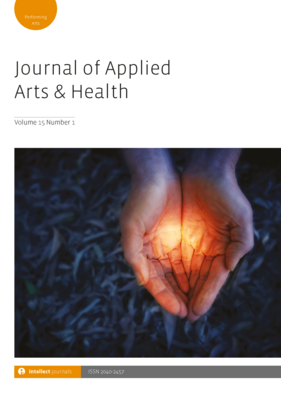
Reflections on the ‘Building Bridges’ in Applied Arts and Health, Education and Community Conference
One Delegate’s Reflections on the ‘Building Bridges’ in Applied Arts and Health, Education and Community Conference - Telford, Shropshire, UK – 7th -10th August 2019.
I was very fortunate to attend the recent ‘Building Bridges in Applied Arts and Health’ conference in Telford organised by Professor Ross Prior and his team from Wolverhampton University. As a seasoned conference delegate and presenter, I found this conference to be one of the most stimulating and enjoyable I have participated in in a long time – a view endorsed by many fellow delegates I spoke to during and after the event.
The aim of the conference was to celebrate the 10th anniversary of the Journal of Applied Arts & Health (JAAH) and, to paraphrase Professor Prior, to bring people together from different art fields, people who work in healthcare and academics, to build community, and to explore what we have in common rather than our differences… to build bridges that will allow us to move away from the silo-like mindset that educational ideologies and practices have instilled around these important domains.
The event was extremely well organised and around a hundred delegates from all over the globe met for five packed and absorbing days, giving the event a truly intercontinental flavour.
Professor Mitchell Kossak from Lesley University led a dynamic and vibrant pre-conference programme that set the tone for the rest of the occasion, while the conference closed with Lifetime Achievement Award presentations and a celebration of the JAAH’s longevity and future
prosperity.
The conference menu itself was a thoughtful and balanced mix of paper presentations, workshops, performances and keynotes – all of which created a relaxed and intimate environment that allowed delegates to explore and engage with current, often very moving and inspiring, developments in research, theory, and practice being carried out by applied arts and health scholars and practitioners in the field.
Meanwhile, our downtime was also amply catered to with trips to the nearby historic village of Ironbridge (the famous bridge itself a powerful metaphor for the conference theme) and a memorable visit the Black Country Living Museum in Dudley on the final afternoon. This excursion included a narrowboat cruise through the Dudley Tunnel, a major artery for the transportation of lime and coal in the late 18th and 19th Centuries, and the boat trip was followed by a sumptuous and lively ‘Black Country Tea Party’ dinner with live music provided by a cracking skiffle band.
The conference had a rites-of-passage and heroic journey flavour to it – well known themes that anthropologist Victor Turner and Joseph Campbell famously describe. Professors Prior and Kossak’s opening invitation to us to perform a body sculpt of an array of bridges - from stepping-stones to suspension bridges – served as an initiation into the stimulating and though- provoking content offered by each presenter and facilitator. From there we were taken on a real journey into the underworld liminality of the Dudley Tunnel and then returned to a joyous evening celebration of food and libation and a wisp of Bacchanalian stomping and dancing.
Nonetheless, the occasion was also a timely opportunity to reflect on some of the enormous challenges and obstacles we are up against in every corner of the world as consequence of so many natural and man-made catastrophes. As practitioners in the field, we don’t need much reminding that art provides a unique conduit through which we can create and find meaning (and therefore, regeneration and healing) through empathic connection to other. Yet we are constantly having to deal with the difficulties in situating the profound and complex, often intractable, ambiguities that characterise much of the work we do in very difficult settings under very difficult circumstances. Nor should we forget that much of this remarkable work is done by remarkable women in the field, as attested to, for example, in the presentations shared by Professors Particia Fenner, Vicky Karkou, Drs Debra Kalmanowitz, Alpha Wooward, and Nisha Sajnani. This aspect needs to be acknowledged and celebrated more fully, as Professor McNiff pointed out in an interview with BBC Radio Shropshire on Day Two of the conference.
The ethos of the conference was best encapsulated, for me, in Professor Kossak’s highly suggestive allusion in his closing keynote, to artist and political activist Paul Robeson’s symbolically defiant act of singing into Canada in the 1950s as a result of a travel ban for his pro-Soviet views at the time. Michel de Certeau’s reflection comes to mind that the bridge, "…is ambiguous everywhere: it alternately welds together and opposes insularities. It distinguishes them and threatens them… it represents a departure, an attack on a state, the ambition of a conquering power, or the flight of an exile… at the same time as it offers the possibility of a bewildering exteriority, it allows or causes the re-emergnece beyond the frontier of the alien element that was controlled in the interior, and gives objectivity (that is, expression and re-presentation) to the alterity which was hidden inside the limits, so that in recrossing the bridge and coming back within the enclosure the traveller henceforth finds there the exteriority that he had first sought by going outside and then … returning…"
How timely, therefore, that Yo-yo Ma performing Bach on the Texas-Mexican border earlier this year felt similarly compelled to proclaim that: "As you all know, as you did and do and will do, in culture, we build bridges, not walls."
In looking back at the Telford conference, its huge success augurs well for the future and I look forward with a keen appetite to the next coming together.
Daniel Stolfi, Ph.D.
Medical anthropologist, arts therapist, and puppeteer.
Chepstow, 23 rd August 2019.

